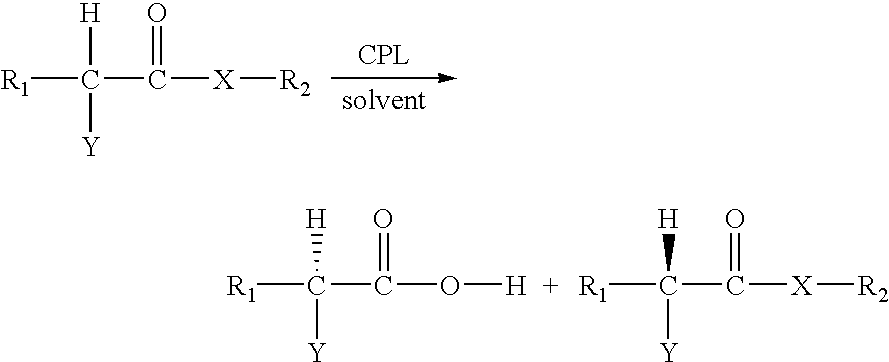Enzymatic resolution of an alpha-substituted carboxylic acid or an ester thereof by Carica papaya lipase
a technology of alpha-substituted carboxylic acid and ester, which is applied in the direction of fertilization, etc., can solve the problems of low tolerance of polar organic solvents, high temperature, and standard kinetic resolution process, and achieves high purity, efficient and economical
- Summary
- Abstract
- Description
- Claims
- Application Information
AI Technical Summary
Benefits of technology
Problems solved by technology
Method used
Image
Examples
example 1
Kinetic Resolution of Racemic (RS)-naproxen 2,2,2-trifluoroethyl Ester by Enzymatic Hydrolysis using Carica papaya Lipase
[0093] A water-saturated organic solvent was prepared using either isooctane or cyclohexane according to the procedures set forth in the preceding section of General procedures II.1.
[0094] Racemic (R,S)-naproxen 2,2,2-trifluoroethyl ester was added to the thus-prepared organic solvent to a concentration of 3 mM. To 15 mL of the thus-obtained racemic (R,S)-naproxen ester solution was added with either crude papain (75 mg) or partially purified Carica papaya lipase (PCPL, 11.3 mg). The resultant mixture was allowed to react with stirring under a selected temperature ranging from 35° C. to 70° C. for a predetermined period of time.
[0095] Aliquots (200 μL) of samples were taken at predetermined time intervals and subjected to HPLC analysis using a (S,S)-WHELK-01 column (Regis Co., Morton Grove, Ill., USA). The mobile phase was a mixture of n-hexane / isopropanol / acet...
example 2
Kinetic Resolution of Racemic (R,S)-naproxen 2,2,2-trifluoroethyl Thioesters by Enzymatic Hydrolysis using Carica papaya Lipase
[0104] According to the procedures set forth in the above Example 1, racemic (R,S)-naproxen 2,2,2-trifluoroethyl thioester was added to a selected water-saturated organic solvent to a concentration of 1 mM. To 15 mL of the thus-obtained racemic (R,S)-naproxen thioester solution was added with either crude papain (1350 mg) or partially purified Carica papaya lipase (PCPL, 203 mg). The resultant mixture was allowed to react with stirring under a selected temperature ranging from 35° C. to 60° C. for a predetermined period of time.
[0105] Aliquots (200 μL) of samples were taken at predetermined time intervals and subjected to HPLC analysis using a Chiralcel OD column (Daicel Chemical Industries, Tokyo, Japan). The mobile phase was a mixture of n-hexane / isopropanol / acetic acid glacial (97:3:1, v / v) at a flow rate of 1.0 mL / min. UV detection at 270 nm was perfor...
example 3
Kinetic Resolution of Racemic (R,S)-fenoprofen 2,2,2-trifluoroethyl Thioester by Enzymatic Hydrolysis using Carica papaya Lipase
[0108] According to the procedures set forth in the above Example 11 racemic (R,S)-fenoprofen 2,2,2-trifluoroethyl thioester was added to a water-saturated isooctane to a concentration of 1 mM. To 15 mL of the thus-obtained racemic (R,S)-fenoprofen thioester solution was added with partially purified Carica papaya lipase (PCPL, 203 mg). The resultant mixture was allowed to react with stirring at 60° C. for a period of 170 hrs. Aliquots (200 μL) of samples were taken and subjected to HPLC analysis using a Chiralcel OD column (Daicel Chemical Industries, Tokyo, Japan). The mobile phase was a mixture of n-hexane / isopropanol / acetic acid glacial (100:1.0:0.5, v / v) at a flow rate of 1.0 mL / min. UV detection at 270 nm was performed for quantification at the column temperature of 25° C.
[0109] The time-course variations of the conversion of (S)-fenoprofen thioeste...
PUM
| Property | Measurement | Unit |
|---|---|---|
| optical purity | aaaaa | aaaaa |
| temperature | aaaaa | aaaaa |
| temperature | aaaaa | aaaaa |
Abstract
Description
Claims
Application Information
 Login to View More
Login to View More - R&D
- Intellectual Property
- Life Sciences
- Materials
- Tech Scout
- Unparalleled Data Quality
- Higher Quality Content
- 60% Fewer Hallucinations
Browse by: Latest US Patents, China's latest patents, Technical Efficacy Thesaurus, Application Domain, Technology Topic, Popular Technical Reports.
© 2025 PatSnap. All rights reserved.Legal|Privacy policy|Modern Slavery Act Transparency Statement|Sitemap|About US| Contact US: help@patsnap.com



